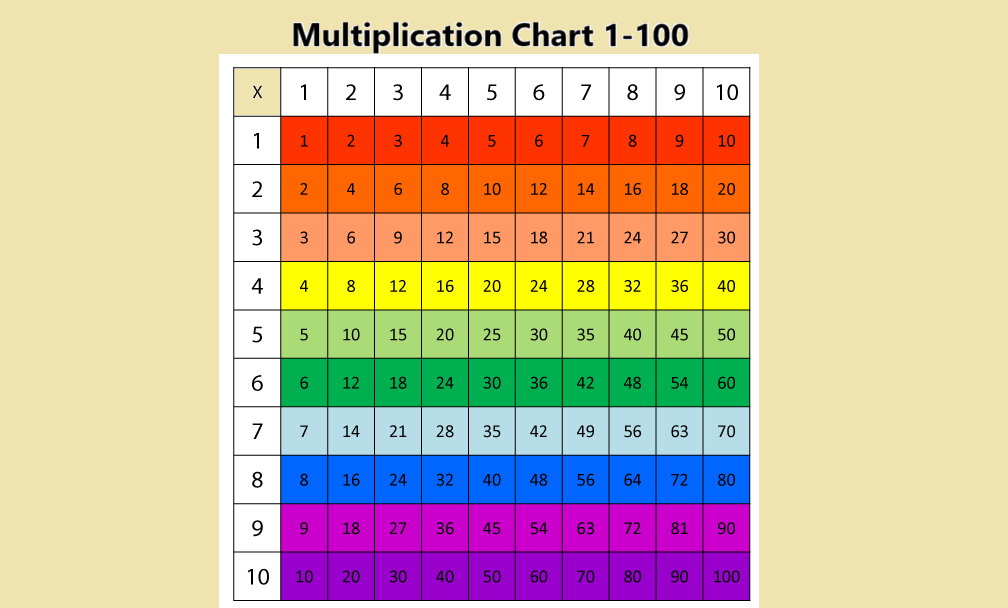Multiplication is a crucial math skill that forms the foundation for many advanced mathematical concepts. One of the best tools to help students, educators, and even math enthusiasts grasp multiplication is a multiplication chart 1-100. While smaller charts (like 1-10 or 1-12) are common, a 1-100 multiplication chart opens up new possibilities for learning and exploration.
What is a Multiplication Chart 1-100?
A multiplication chart 1-100 is a large grid displaying the products of numbers ranging from 1 to 100. The numbers 1 through 100 are listed along both the top row and the left column. The intersecting cell at any row and column contains the product of those two numbers.
For example:
- To find the product of 23 and 47, locate 23 on the left column and 47 on the top row. The intersecting cell shows the product: 1,081.
Why Use a Multiplication Chart 1-100?
- Comprehensive Learning
A 1-100 chart allows students to explore multiplication beyond the basics. It is particularly useful for middle and high school students who deal with larger numbers in math problems. - Pattern Recognition
The chart vividly illustrates patterns in multiplication, such as:- Products in rows or columns of even numbers are always even.
- Numbers in the diagonal cells (like 2×2, 3×3, 4×4) are perfect squares.
- Multiples of 10 in a row always end with zero.
- Real-Life Application
Larger multiplication tables are practical for real-world applications, such as calculating areas, understanding ratios, or working with large datasets in science or economics. - Memory Aid for Advanced Students
While smaller charts are great for beginners, a 1-100 chart challenges more advanced learners to expand their memorization and mental math skills.
How to Use a Multiplication Chart 1-100 Effectively
- Start with Familiar Sections
Beginners can focus on the smaller 1-10 grid within the larger chart. Gradually, they can expand to include higher numbers. - Break It Down
Divide the chart into sections. Work on mastering one range (e.g., 1-20) before moving on to the next. - Identify and Memorize Patterns
Encourage students to look for relationships between rows and columns. For example:- Multiples of 5 create a pattern of alternating 0s and 5s in the units place.
- Rows and columns for prime numbers (e.g., 7, 13, 29) show no repeating products other than multiples of the prime itself.
- Use It as a Reference
For students struggling with larger numbers, the chart serves as a quick reference, helping them verify calculations and build confidence.
Printable Multiplication Chart 1-100
Printable versions of the 1-100 multiplication chart are widely available online. These charts can be customized based on your needs:
- Color-coded charts to highlight patterns like even and odd numbers or perfect squares.
- Blank charts where students fill in the products as a practice exercise.
Advanced Applications
A 1-100 chart isn’t just for students. It can also be a helpful tool for:
- Researchers and scientists working with data tables or mathematical models.
- Engineers and architects calculating dimensions and areas.
- Gamers and puzzle enthusiasts solving complex problems involving numerical patterns.
The Value of Multiplication Beyond 1-12
While the traditional 1-12 multiplication table is essential for foundational learning, the 1-100 chart encourages deeper mathematical thinking. It bridges the gap between basic arithmetic and more advanced topics like algebra, geometry, and calculus.
Conclusion
The multiplication chart 1-100 is a powerful tool for anyone looking to enhance their mathematical skills. Whether you’re a student, teacher, or math enthusiast, this comprehensive chart provides opportunities for learning, discovery, and problem-solving.
With dedication and practice, this chart can transform how you view and work with numbers, making math an enjoyable and accessible subject. So, grab a 1-100 multiplication chart today and start exploring the limitless possibilities of multiplication!



Leave a Reply